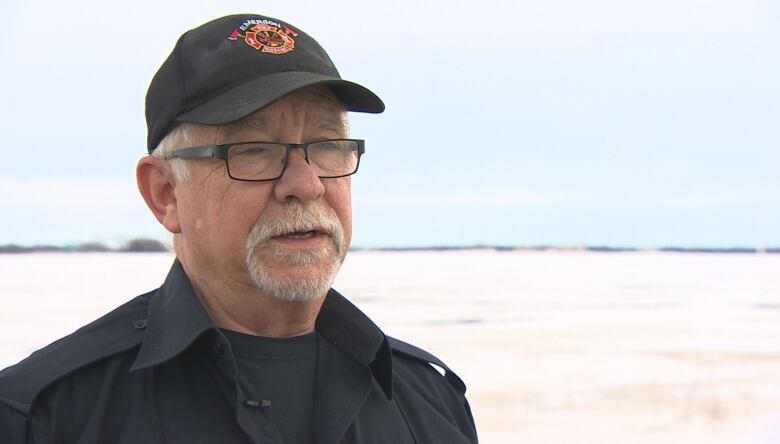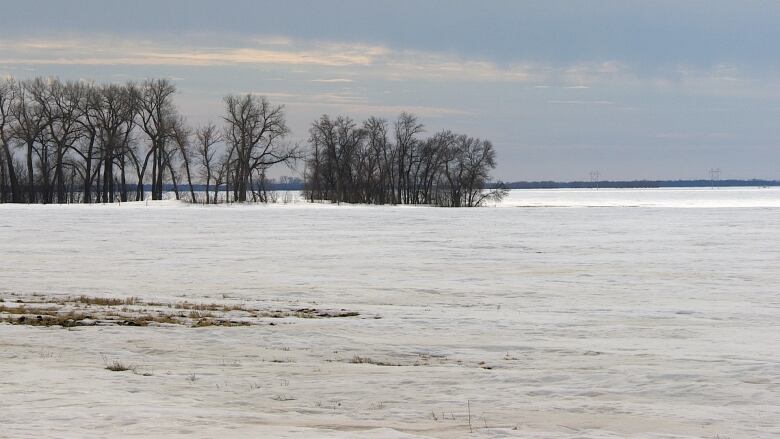'We're going to run into problems': Manitoba flood would endanger asylum seekers
Since the start of the year, 111 asylum seekers have snuck into Manitoba near Emerson

A high risk of flooding near the Manitoba border this spring has officials in Emerson worried about the dangers that will pose to a continuing stream of asylum seekers crossing into the province.
"These people are freezing out there. If we do get a spring flood now, that's going to spread them outand are we going to have to do water rescues?" saidGregJanzen,reeve of the municipality of Emerson-Franklin.
"I don't know that we're equipped for that."
Since the start of the year, 111 asylum seekers have snuckinto Manitoba near Emerson, often crossing through fields of hip-deep snow.
- At least 22 more asylum seekers, baby, cross into Manitoba Sunday
- Asylum seeker says husband, mother were killed on wedding day in Somalia
Soon, that snow will melt and turn the fields into wetlands. But the situation could become more dire, and the water much deeper, if flood forecasts hold true.

The latest outlook from the U.S. National Weather Service calls for a "greater than 65 per cent" chance of major flooding on the Red River in Pembina, N.D., about five kilometres south of Emerson.
The Red River flows north, bringing that floodwater into Manitoba, spreading it across fields. Although Emerson is protected by a dike, outlying areas are not.
"If it's a 65 per cent of flood, we probably will see a few issues with the way they are coming across the border," said Emerson fire chiefJeff French.
The town's 21 volunteer firefighters are getting ready for potential water rescues, he said. They are equipped with two water rescue crafts as well asairboats andzodiacs. French said he is also looking at more training for members.
"Being cold in the snow is one thing but being wet and cold, that's a whole different story. We might see some more cases of hypothermia," he said.
- Southwestern Manitoba faces high risk of spring floods
- 'We're in a fragile situation': Manitoba communities brace for possible major spring flooding
"Water all the way around the town, that's on the bigger floods, but even small, moderate floods, the fields do go under water," Emerson's reeve said,describing the scene around the small town in flood years.
"Someone who doesn't know the lay of the land and is walking in the middle of the night, trying to get across the border, they don't know the lay of the land. We're going to run into problems,"Janzen said.
Depending on the crest of the flood, the fields could be under as much as a metre of water, he said, adding that is cold, often fast-moving water.
Manitoba's last flood update, at the end of January, also said there'sa risk of major flooding on the Red River. The next update is expected on Monday.
University of Manitoba civil engineering professor and flood expertJay Doeringsaid givenrecent mild temperatures, the flood risk should be slightly lower than it was earlier this winter. Still, he said, expect to see some very wet fields and higher river levels.
"Acouple of weeks out from now we can expect to see a significant amount of water assuming things do melt as planned," he said.
'It's kind of chaotic'
Janzen,the local reeve,is one of many calling for the federal government to amend or temporarily suspend the Safe Third Country Agreement between Canada and the U.S.
The 2004 pact requires asylum seekers to apply for refugee status in the first safecountry in which they arrive.
The way the law stands, they have to come across theborder illegally before they can seek asylum.- GregJanzen
That means Canada sends back claimants enteringthe country via official ports of entry along the land border with the U.S.
It's because of that agreement that migrants are sneaking into the country rather than crossing the border at the legal port of entry, Janzen said.
"The way the law stands, they have to come across the border illegally before they can seek asylum," he said.
- Petition calls on federal government to act on migrant crisis
- Manitoba NDP joins call to end controversial Canada-U.S. Safe Third Country Agreement
- Scrap safe country pact with U.S., advocates and professors urge Ottawa
If the agreement were suspended and asylum seekers knew they would not be sent back to the U.S., the current problems could be alleviated somewhat, Janzen said, mitigating safety risks for migrants and the people who may need to risk their own safety trying to find them.
"We need to get this organized here and do it in an orderly manner. Right now, it's kind of chaotic, the way things are happening," Janzen said.
- 'They almost froze to death': Refugees frostbitten after walking to Manitoba border
- Somali refugee claimant swims across Red River, arrives in Manitoba
Jay Ihme, a volunteer firefighter and EMT with Emerson's fire and rescuedepartment, is worried members will begin to be run ragged from responding to regular calls crashes and medical emergencies on top of the calls to help asylum seekers.

"It starts to tax people. So far everybody's holding up well but it does start to get [to be] a bit much after a while," he said, adding he's been called out about a dozen times and has seen people ranging in age from six months to their 40s.
"You can imagine here, at 3 a.m., it's 30-below, pitch black, and you're trying to find someone in these snow-covered fields. It's tough."
-
Full coverage:Refugees crossing the U.S. border into Manitoba
Many migrants have been treated for frostbite on fingers and toes because often they lose shoes and socks while trudging through the snow,Ihme said.
"First your boots come off, then your socks come off then you can't move and you're tired anyway. If it gets really saturated wet ... they can't move in these fields. You just can't go," he said,standing alongside afield where he's found some people.
"I wouldn't be able to make it from here to those trees in soggy, mucky, yucky. I just don'tthink they'll make it."
Aside from snow and mud, they often face bush, thick brush, fences and barbed wire in their travels through those fields, Ihme added.
"It's a tough slog."

with files from Courtney Rutherford













_(720p).jpg)


 OFFICIAL HD MUSIC VIDEO.jpg)
.jpg)



























































































